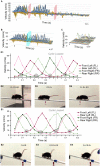An integrated workflow for 2D and 3D posture analysis during vestibular system testing in mice
- PMID: 38107632
- PMCID: PMC10722188
- DOI: 10.3389/fneur.2023.1281790
An integrated workflow for 2D and 3D posture analysis during vestibular system testing in mice
Abstract
Introduction: Posture extraction from videos is fundamental to many real-world applications, including health screenings. In this study, we extend the utility and specificity of a well-established protocol, the balance beam, for examining balance and active motor coordination in adult mice of both sexes.
Objectives: The primary objective of this study is to design a workflow for analyzing the postures of mice walking on a balance beam.
Methods: We developed new tools and scripts based on the FluoRender architecture, which can interact with DeepLabCut (DLC) through Python code. Notably, twenty input videos were divided into four feature point groups (head, body, tail, and feet), based on camera positions relative to the balance beam (left and right), and viewing angles (90° and 45° from the beam). We determined key feature points on the mouse to track posture in a still video frame. We extracted a standard walk cycle (SWC) by focusing on foot movements, which were computed by a weighted average of the extracted walk cycles. The correlation of each walk cycle to the SWC was used as the weight.
Results: We learned that positions of the camera angles significantly improved the performance of 2D pose estimation (90°) and 3D (45°). Comparing the SWCs from age-matched mice, we found a consistent pattern of supporting feet on the beam. Two feet were consistently on the beam followed by three feet and another three feet in a 2-3-3 pattern. However, this pattern can be mirrored among individual subjects. A subtle phase shift of foot movement was also observed from the SWCs. Furthermore, we compared the SWCs with speed values to reveal anomalies in mouse walk postures. Some anomalies can be explained as the start or finish of the traversal, while others may be correlated to the distractions of the test environment, which will need further investigation.
Conclusion: Our posture analysis workflow improves the classical behavioral testing and analysis, allowing the detection of subtle, but significant differences in vestibular function and motor coordination.
Keywords: AI; ML; balance; coordination; inner ear; multisensory; spatial orientation.
Copyright © 2023 Wan, Edmond, Kitz, Southern and Holman.
Conflict of interest statement
The authors declare that the research was conducted in the absence of any commercial or financial relationships that could be construed as a potential conflict of interest.
Figures








References
-
- Cao Z., Simon T., Wei S.-E., Sheikh Y. (2017). Realtime multi-person 2D pose estimation using part affinity fields. arXiv:1611.08050v2. - PubMed
Grants and funding
LinkOut - more resources
Full Text Sources
Molecular Biology Databases

